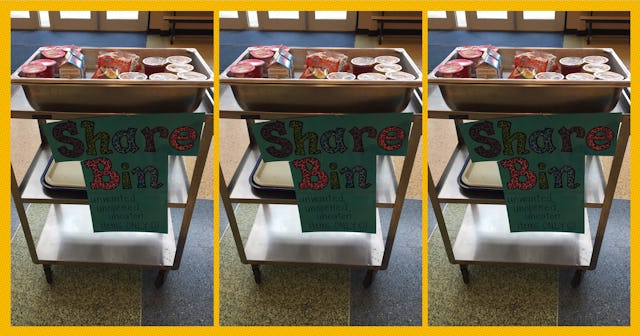What’s A Share Table? The Answer — Plus, How (& Why) To Start One At Your Kid’s School
The program helps ensure that uneaten and unopened cafeteria food never again goes to waste.

According to the United States Department of Agriculture (USDA), more than 34 million Americans, including 9 million children, are food insecure, which means they experience a lack of consistent access to enough food to support an active, healthy lifestyle, either temporarily or long-term.
That number is especially staggering when you consider that the U.S. is the richest country in the entire world, with more than enough resources to ensure no one ever has to go hungry. Food waste in the U.S. is also a tremendous issue, with the USDA estimating that between 30-40 percent of our food supply ends up in landfills instead of feeding those who might need it.
These stats are grim, and there's a good chance your neighbors or your child's friends have experienced food insecurity. So, how can you help? Turns out, something called a "share table" or "share bin" can help ensure kids have open access to safe food to eat when they're at school.
What is a share table?
Back in 2016, the USDA backed the initiative in order to "encourage the consumption of nutritious foods and reduce food waste" in schools. Essentially, share tables are bins, tables, carts, or stations located in K-12 schools where students can deposit unopened food items they don't want or need so that other students can freely take and enjoy them.
Typically, the offerings are packaged and non-perishable. However, some schools have had success with juices and milks, with a San Antonio elementary school principal telling local outlet KSAT in 2018 that items placed on the school's share table are taken "almost immediately." Other popular items include yogurt, cheese sticks, crackers, muffins, and peeled fruits such as bananas and oranges.
How do share tables cut down on food waste?
"It was hard because kids would ask, 'Do you mind if I can have this for my friends?' And many times we'd have to tell them no," Kittiya Johnson, principal at Cody Elementary School, told the outlet. "We did see quite a bit of waste. The kids would comment on it. 'Well, are we just gonna throw it away?' And also the teachers would make those comments."
The program was such a success that the state passed the Texas Student Fairness in Feeding Act in late 2017, authorizing school districts to distribute excess food to children any way they see fit, with these share tables serving as an easy and effective way to get that food into the hands of students of all ages without hassle.
And while the National School Lunch Program (NSLP) does help to provide low-cost or free meals to students nationwide, the program's restrictions don't account for reducing food waste, as cafeterias can only serve food prepared same-day, and students are required to take a certain amount of food, even if they don't like a particular item or aren't that hungry.
Share tables can help bridge that gap, inviting kids to drop off an item they don't want in exchange for something they prefer. Any food leftover can then be donated to local food banks or other nonprofit organizations to be distributed to the broader community or given to kids to take home to their families.
How can you help set up a share table at your kid’s school?
To find out if your district already has a food waste program or share tables in place, checking in with your food services director or cafeteria manager is a solid first step. If you'd like to spearhead setting it up, K-12 Food Rescue and the USDA are two great resources. You'll find tips and guidelines on getting started as well as info on how to follow the local and state health department requirements your district would need to adhere to, such as only allowing packaged foods to prevent contamination or time/temperature control measures for perishable items to avoid spoilage. Some states require a staffer to monitor the share bin at all times, and some require that leftover food be donated at the end of the day.
The process will involve connecting with your local health department to ensure adherence to any rules or regulations and training staff on proper food safety requirements. So, while some steps are needed to implement the program, it's entirely doable as long as you work with your district to check all the necessary boxes.
Of implementing share tables at her Wisconsin school district, Bobbie Guyette, supervisor of school nutrition, told Food Management in 2017: "You have to talk a lot with your administration. I sought their approval first and then communicated with the principal at each site before moving forward. I also send communication to all staff at the site so everybody is aware [of what we're doing], and they're educating the kids before they even get to the lunchroom."
The payoff is worth the pursuit, even if just one student is able to access food to enjoy when they are hungry. No child should ever have to feel famished, and there's no reason for perfectly good food to go to waste.
This article was originally published on